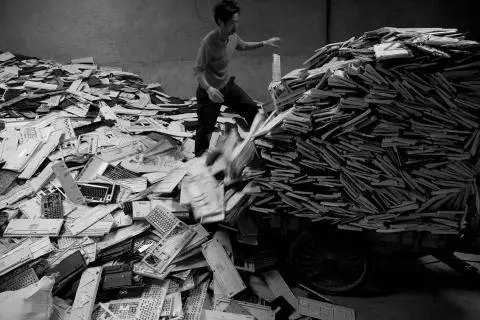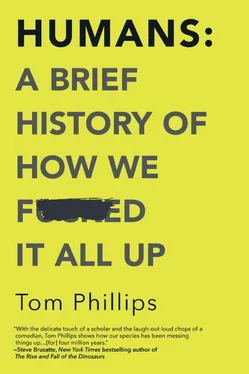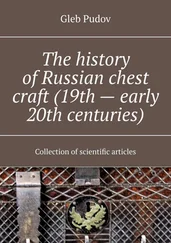Tom Phillips - Humans - A Brief History of How We F*cked It All Up
Здесь есть возможность читать онлайн «Tom Phillips - Humans - A Brief History of How We F*cked It All Up» весь текст электронной книги совершенно бесплатно (целиком полную версию без сокращений). В некоторых случаях можно слушать аудио, скачать через торрент в формате fb2 и присутствует краткое содержание. Город: Toronto, Год выпуска: 2019, ISBN: 2019, Издательство: Hanover Square Press, Жанр: История, Юмористические книги, на английском языке. Описание произведения, (предисловие) а так же отзывы посетителей доступны на портале библиотеки ЛибКат.
- Название:Humans: A Brief History of How We F*cked It All Up
- Автор:
- Издательство:Hanover Square Press
- Жанр:
- Год:2019
- Город:Toronto
- ISBN:978-1-48805-113-5
- Рейтинг книги:4 / 5. Голосов: 1
-
Избранное:Добавить в избранное
- Отзывы:
-
Ваша оценка:
- 80
- 1
- 2
- 3
- 4
- 5
Humans: A Brief History of How We F*cked It All Up: краткое содержание, описание и аннотация
Предлагаем к чтению аннотацию, описание, краткое содержание или предисловие (зависит от того, что написал сам автор книги «Humans: A Brief History of How We F*cked It All Up»). Если вы не нашли необходимую информацию о книге — напишите в комментариях, мы постараемся отыскать её.
Humans: A Brief History of How We F*cked It All Up — читать онлайн бесплатно полную книгу (весь текст) целиком
Ниже представлен текст книги, разбитый по страницам. Система сохранения места последней прочитанной страницы, позволяет с удобством читать онлайн бесплатно книгу «Humans: A Brief History of How We F*cked It All Up», без необходимости каждый раз заново искать на чём Вы остановились. Поставьте закладку, и сможете в любой момент перейти на страницу, на которой закончили чтение.
Интервал:
Закладка:
Large bodies of water erupting into flames may be one of the more dramatic examples of humanity’s unerring ability to take the natural world around us and make it worse, but they’re hardly alone. The world is full of examples of how we’ve managed to make a huge mess basically everywhere we’ve gone. Did you know there’s a vast “dead zone” in the Gulf of Mexico? It’s a massive plume of mostly ruined sea, spreading out from where the fertilizer running off the agricultural lands of the southern USA has caused great algal blooms, the algae going hog-wild and robbing the water of oxygen, killing everything else that isn’t algae. Good work, guys!
Or how about our fondness for just throwing stuff away without really considering that it has to end up somewhere, which has given rise to the massive electronic wasteland of Guiyu in China, an infamous 20-square-mile graveyard of the world’s unwanted gadgets, piled high with outdated laptops and last year’s smartphones. Technically Guiyu is in the business of recycling, which is good! Unfortunately (until recently), it was also hell on earth, with thick plumes of black smoke filling the air, toxic heavy metals leaching into both the soil and the people after the scrap is washed with hydrochloric acid, and the smell of burning plastic everywhere. (That was until the Chinese government cracked down on it in the past few years, enforcing higher health and safety standards—after which one resident told the South China Morning Post that the air quality was much improved. “You can only smell the burning of metal when you are really close,” Yang Linxuan said.)

Perhaps our most impressive piece of work is the Great Pacific Trash Vortex. It’s almost poetic that in the middle of the ocean there’s a vast, swirling rubbish dump of crap we’ve casually disposed of—an area the size of Texas where the ocean currents of the North Pacific Gyre keep our waste products endlessly circling around the sea. Mostly made from microscopic particles of plastic and fragments of discarded fishing equipment, it’s invisible to the naked eye, but for marine life it is a very real thing. Scientists recently estimated that since we started the widespread use of plastic in the 1950s, we’ve made over 8,300 million tons of it. Of that, we’ve thrown away 6,300 million tons, which is now just hanging around the surface of the earth. Yay, humans.
But if you want the most poignant example of how humans can destroy their own habitat without really meaning to, you need to look to an island covered in massive stone heads.
When the first Europeans landed on Easter Island in 1722 (a Dutch expedition that was looking for a supposedly undiscovered continent that doesn’t exist, the idiots), they were baffled. How could this tiny, profoundly isolated Polynesian nation, lacking modern technology or any trees, possibly have erected the vast, elaborate statues—some of them 70 feet tall and weighing almost 90 tons—that covered major parts of the island?
Obviously, the Netherlanders’ state of curiosity didn’t last long: they quickly set about doing their regular European thing, namely shooting a bunch of the local inhabitants dead after a series of misunderstandings. Over the next few decades, further European visitors did more of the stuff that Europeans tended to do in places they’d just “discovered,” like introducing deadly new diseases, kidnapping the local population into slavery and generally patronizing the hell out of them. (See the later chapter on colonialism.)
Over the following centuries, white people would come up with a bunch of theories about how those mysterious statues could possibly have appeared on an island full of “primitive” people—mostly involving implausible ocean crossings from faraway continents, or sometimes aliens. (“Aliens must have done it” is a remarkably popular and obviously extremely rational solution to the conundrum of nonwhite people building things that white people can’t imagine them having built.) The answer to the question is, of course, obvious: the Polynesians put them there.
At the time they first landed on Rapa Nui (to give it its local name), the Polynesians were one of the great world civilizations who had explored and settled on islands across thousands of miles of ocean. Meanwhile, a few stray Vikings aside, Europeans hadn’t really got out of their backyards.
Rapa Nui was home to an advanced culture, with intergroup cooperation, intensive agriculture, a socially stratified society and people commuting to work: basically all of the bullshit that we generally associate with being fancy and proper. The statues— moai in Polynesian—were the crowning achievement of an art form common to other Polynesian societies. They were important to Rapa Nui’s society for both spiritual and political reasons, honoring the ancestors whose faces they depicted, while functioning as symbols of prestige for those who ordered their construction.
So the puzzle turned into a different one: not how did the statues get there, but instead, where had all the trees gone? Because however the Rapa Nui people got those statues into place, they’d have needed a ton of big-ass logs to do it. And how did the mighty civilization that put them there turn into the small society of subsistence farmers with threadbare canoes that greeted (and then got shot by) those first Dutch sailors?
The answer is that the Rapa Nui people both got unlucky, and fucked up.
They got unlucky because, it turns out, their island’s geography and ecology was unusually vulnerable to the effects of deforestation. As Jared Diamond (he of the “agriculture was our biggest mistake” theory) explains in his book Collapse —which puts the people of Rapa Nui front and center—compared to most Polynesian islands, Easter Island is small, dry, flat, cold and remote: all things that make it less likely that the trees you cut down will get naturally replaced.
And they fucked up because, in their efforts to keep building better houses and better canoes and better infrastructure to move statues into place, they kept cutting the forest down, maybe not realizing that those trees wouldn’t come back, until suddenly there were no more left. It was the tragedy of the commons writ large. Nobody cutting down any single tree was responsible for the problem, up until it was too late: at which point everybody was responsible.
The effects were devastating to Rapa Nui’s society. Without the trees, they couldn’t make the canoes that let them fish in the open ocean; the rootless and unprotected soil started to erode in the wind and rain, becoming infertile and causing landslides that wiped out villages; in the cold winters, they were forced to burn much of the remaining vegetation to stay warm.
And as things got worse, competition between groups for increasingly scarce resources increased. This seems to have led to an outcome that was tragic but weirdly predictable, given how people often act in a desperate situation where they’re hungry for social standing, or morale, or just a bit of reassurance that they haven’t made a terrible mistake. They didn’t stop. In fact, they doubled down. The people of Rapa Nui appear to have thrown themselves into building ever larger and larger statues, because… well, that’s pretty much what humans always do when faced with a problem that they’re worried they can’t solve. The last statues carved on the island never even made it out of the quarry, while others lie toppled by the wayside, never having reached their destination as the whole project collapsed.
Читать дальшеИнтервал:
Закладка:
Похожие книги на «Humans: A Brief History of How We F*cked It All Up»
Представляем Вашему вниманию похожие книги на «Humans: A Brief History of How We F*cked It All Up» списком для выбора. Мы отобрали схожую по названию и смыслу литературу в надежде предоставить читателям больше вариантов отыскать новые, интересные, ещё непрочитанные произведения.
Обсуждение, отзывы о книге «Humans: A Brief History of How We F*cked It All Up» и просто собственные мнения читателей. Оставьте ваши комментарии, напишите, что Вы думаете о произведении, его смысле или главных героях. Укажите что конкретно понравилось, а что нет, и почему Вы так считаете.












